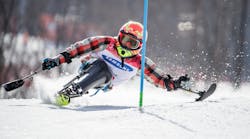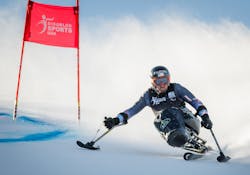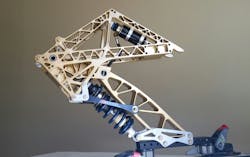Like every competitive racing athlete, Christopher Young stays acutely attuned to his equipment. Whether it’s auto racing, bicycling, skiing, or any other event where equipment plays an important role in performance, athletes in those sports can feel instantly when their machine is working properly.
In Young’s case, however, the margin for error is uniquely tight. Young was injured in a plane crash in Alaska in 1982 while serving in the United States Coast Guard. The accident left him paralyzed from the knees down and partially paralyzed below the waist. He was introduced to skiing and racing at a Veterans Administration Winter Sports Clinic and is now a five-time member of the U.S. Paralympic team and multiple Paralympic medalist.
As an adaptive skier who reaches speeds of 70 mph, Young relies on his monoski to keep him competitive and safe. He has significant and rare athletic gifts, but his racing career could come crashing down at any moment if his sled malfunctions. “My life, literally, depends on the machine not breaking,’’ Young said. “There are some places on ski slopes where falling is not an option. If you fell, you would go off the cliff—it’s the end, goodbye.”
For the past seven years, Young has been using equipment made by DynAccess Ltd., a Pennsylvania business that designs and manufactures outdoor equipment for physically challenged individuals and athletes. Joachim Grenestedt works as the chief engineer and product designer for DynAccess, while his wife, Channy Tokura, runs the business side.
Chris Young, one of the world’s most accomplished Paralympic skiers, has been using adaptive skiing equipment manufactured by DynAccess for the past seven years. (Credit: Joe Kusumoto Photography)
Developing the Monoski
Grenestedt had used his engineering expertise to design land speed racers, boats, and aircraft. He turned to designing monoskis when a former student was injured in an accident and lost the use of his legs. “I’d seen a lot of these adaptive skiing programs and it is truly amazing what some people can do,’’ Grenestedt said in an interview with Lehigh University. “Skiing is a high-adrenaline outdoor sport with lots of action, and I love it.”
While watching his student, Grenestedt noticed a number of the monoskis were broken. “I believed we could design and manufacture a better sled,’’ he said. Tokura started DynAccess Ltd. in 2011 after receiving a Technology Transfer Grant from the Keystone Innovation Zone. Word traveled quickly in the tight-knit adaptive skiing community.
A monoski consists of a bucket seat and a stiff and strong frame with suspension mounted to a single ski. To make sure monoskis are durable, adjustable, and responsive DynAccess uses shock absorbers specifically developed for monoski applications. All of the shocks are hand-built by Penske Racing Shocks technicians to order, and they all undergo dyno-testing.
The Hydra 2 monoski is one of four models manufactured by DynAccess, an eight-year-old Pennsylvania company. The monoskis include plastic bearings manufactured by igus that are maintenance-free and corrosion-resistant. (Credit: DynAccess, Ltd.)
Corrosion-Resistant Plastic Components
Besides the shock absorbers, some other key components on monoskis are flanged bearings. It is important to consider ambient conditions, which for skiing should consider high compressive strength, low moisture absorption, and temperature. These materials properties can also be found in bearings frequently found in woodworking, aerospace engineering, plastic processing, and beverage technology and iglide T500.
“We tried other components and they worked fine, but the igus products have worked better,’’ Grenestedt said. By finding industrial parts to troubleshoot a recreational product, DynAccess believes it is able to help all skiers.
The Best in Adaptive Equipment
Young won his first gold medal in the Paralympic Games in 1994, and became the first Paralympian to win two medals when he won a gold and a silver in the 2002 Paralympic Games in Salt Lake City. He won the Mono Skier competition at the 2015 X Games, becoming the oldest gold medalist in the history of the competition.
On the slopes and off, Young’s physical challenges give him the perspective to know when engineering and technical expertise work together to improve his quality of life and athletic performance.



